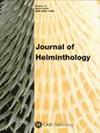Identification of Lepidapedon oregonense as the current world's deepest trematode.
IF 1.3
3区 生物学
Q4 PARASITOLOGY
引用次数: 0
Abstract
The deepest recorded depth for trematodes currently stands at approximately 6200 m. This depth record was achieved solely through sequence datasets of Lepidapedon sp. obtained from a gastropod. Given that trematodes of this genus typically use fish as definitive hosts, the origin of the trematode sequence was thought to be larval stages. However, the specific species remained unclear owing to the absence of reported adult-stage sequences. In the present study, we definitively identified the deepest trematode as Lepidapedon oregonense by comparing 28S ribosomal DNA sequences from adult worms from the macrourid fish Coelorinchus gilberti with data from the gastropod in the previous study.
确定 Lepidapedon oregonense 为目前世界上最深的吸虫。
目前记录到的最深的吸虫深度约为 6200 米。鉴于该属的吸虫通常以鱼类为最终宿主,吸虫序列的来源被认为是幼虫阶段。然而,由于缺乏成虫阶段序列的报道,具体物种仍不清楚。在本研究中,我们通过比较大口鱼Coelorinchus gilberti成虫的28S核糖体DNA序列与之前研究中腹足纲动物的数据,最终确定最深的震颤虫为Lepidapedon oregense。
本文章由计算机程序翻译,如有差异,请以英文原文为准。
求助全文
约1分钟内获得全文
求助全文
来源期刊

Journal of Helminthology
生物-动物学
CiteScore
2.80
自引率
12.50%
发文量
127
审稿时长
3 months
期刊介绍:
Journal of Helminthology publishes original papers and review articles on all aspects of pure and applied helminthology, particularly those helminth parasites of environmental health, medical or veterinary importance. Research papers on helminths in wildlife hosts, including plant and insect parasites, are also published along with taxonomic papers contributing to the systematics of a group. The journal will be of interest to academics and researchers involved in the fields of human and veterinary parasitology, public health, microbiology, ecology and biochemistry.
 求助内容:
求助内容: 应助结果提醒方式:
应助结果提醒方式:


